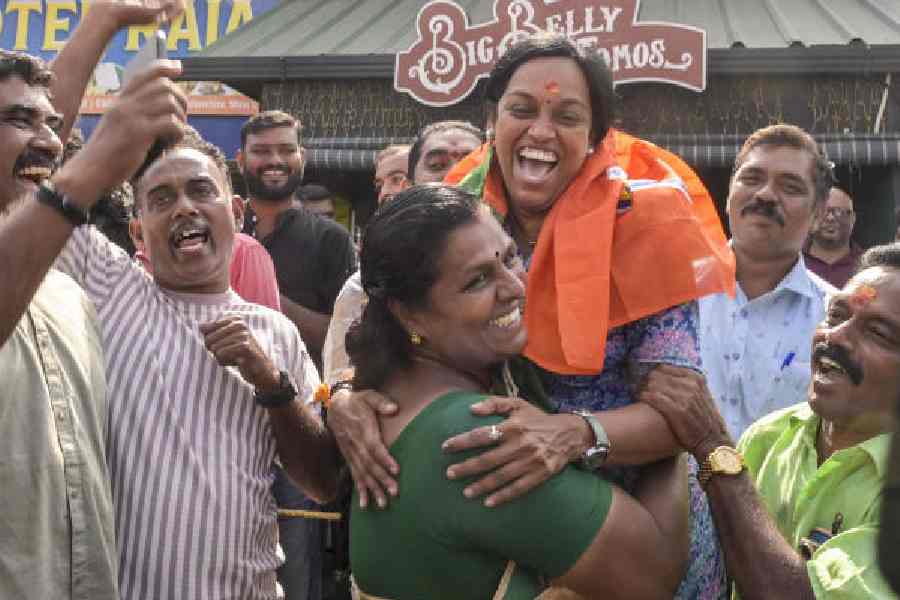Film director Sudeep Ranjan Sarkar is all set to travel to Cannes this week with his best friend — the iPhone, which has changed the way he shoots films. Last year when the 47-year-old had visited the city on the French Riviera to promote his film Lust, he had an idea that was sparked off by the many billboards one finds outside airports — Apple’s ‘Shot on iPhone’. He decided to shoot a complete film which he will promote this year — Glorious Dead on May 19. Presented by Rita Jhawar, 54, and Calcutta-based NEZ Moving Pixels, Sudeep tells The Telegraph: “Technology is democratising filmmaking. The iPhone, for me, is proving to be a game changer. It has changed the way we perceive videos.”
Filmmed at Cannes, Grasse (near Cannes), Benares and Tinchuley, Sudeep says: “I was greatly influenced by Cloud Atlas and it remained at the back of my mind. Also, I am a voracious reader. I was reading up on the connection between women and religion; how they have always been the deciding factor in every aspect of life. I wanted to tell a story of women empowerment.”
Here’s more from the man about his experiments with the iPhone.
What made you choose the iPhone to shoot Glorious Dead?
I have been influenced by Steven Soderbergh and Sean Baker, who did Tangerine, both of whom have used the iPhone to shoot films. Whenever I come out of airports, I see billboards with lovely photographs and the line: “Shot on iPhone.” We also keep reading about phones with three-four lenses and 13MP or 30MP cameras. In the last two-three years I have noticed that phone companies have shrunk the camera into a pocket-worthy device. This made me explore Soderbergh’s Unsane and Baker’s Tangerine. For Soderbergh it was more of an experiment. But for me it was different.
When I was at Cannes last year with my film Lust, I decided to shoot the film that I will promote this year — Glorious Dead — on the iPhone 8 Plus (256GB). Besides the phone, I had a lens cover and a gimbal (a pivoted support that allows the rotation of an object) to stablise shots. All the equipment could fit into my coat pocket. I thought if the film doesn’t work out, I would simply delete all the files on the phone. After all, I had a script ready for my run-and-gun kind of film.
You have an Albanian-American co-producer?
Vito Shakaj. I was supposed to be in Albania for the Tirana International Film Festival last year and I had been in touch with an Albanian gentleman, who is an American citizen. Meanwhile, the films that I have made so far, have been appreciated in Albania. He was happy to see what I was doing.
Did the iPhone make the process easier?
With the iPhone in my hand I could go and film the people watching my film (Lust) in pitch darkness (at Cannes last year). Nobody stopped me because I was shooting on a phone. Further, I shot it in 4K raw. And on my phone was the app FiLMiC Pro.
Glorious Dead has been shot in Cannes, Grasse (near Cannes), Benares and Tinchuley. When I shot in Benares, the filming for the Amazon Prime series Mirzapur was also on. So, people expected a big crew. But all I had was the iPhone 8 Plus. When I showed my 90-minute film to my co-producer, Vito Shakaj, he was impressed how a full-length feature film could be shot on a low budget.
The film proves two things — that a device which could be kept inside one’s pocket can also shoot a film and second, other mobile phone companies should feel encouraged. Samsung can look at something similar on their latest devices (Galaxy S10 series) or Huawei on its P30 Pro.
Technology is democratising filmmaking. The iPhone, for me, is proving to be a game changer. It has changed the way we perceive videos. In the film, there is a German actress, a Russian actress, an Albanian actor and then there are other characters. If I hadn’t told you this was shot on an iPhone, you wouldn’t have realised it easily.

The gadgets close to director Sudeep Ranjan Sarkar’s heart Picture: B. Halder
What were the challenges of using the iPhone?
The sensor is small compared to full-frame cameras. And you don’t have interchangeable lenses. At this point, the iPhone (8 Plus) is not a substitute for a DSLR camera. I am looking for a better depth of field. Yet, what the iPhone lets you achieve is outstanding.
I come from Dhanbad and when I was small we had seen films using projection in the middle of a field. I have seen Sholay in a tent set-up. What attracted me was great storytelling, which made me watch Satyajit Ray and Ingmar Bergman. Of course, I wasn’t oblivious to Bollywood; I am great fan of Sunny Deol and Dharmendra.
I am amazed by what a filmmaker can do with just a phone. I can shoot in 4K and people can watch a film on very high-resolution screens. People are watching Netflix and Amazon shows on the phone. Also, Apple and Disney are coming up with its streaming services, which means the phone is becoming the centre of one’s viewing experiences. With the iPhone XS more can be achieved. Things are getting better.
Do you enjoy Cannes?
I feel that the Indian presence in Cannes has become about Sonam Kapoor, Deepika Padukone and others walking the red carpet in gorgeous dresses. That’s fine but where are the films? Recently, there was this gem of a film called Village Rockstars and I think we should focus on these gems rather than high-profile stars. This will be my third year at Cannes, and all that I have learnt is that only good films remain. I believe only content-driven movies would survive. Young filmmakers are working with smaller budgets but delivering good content.











